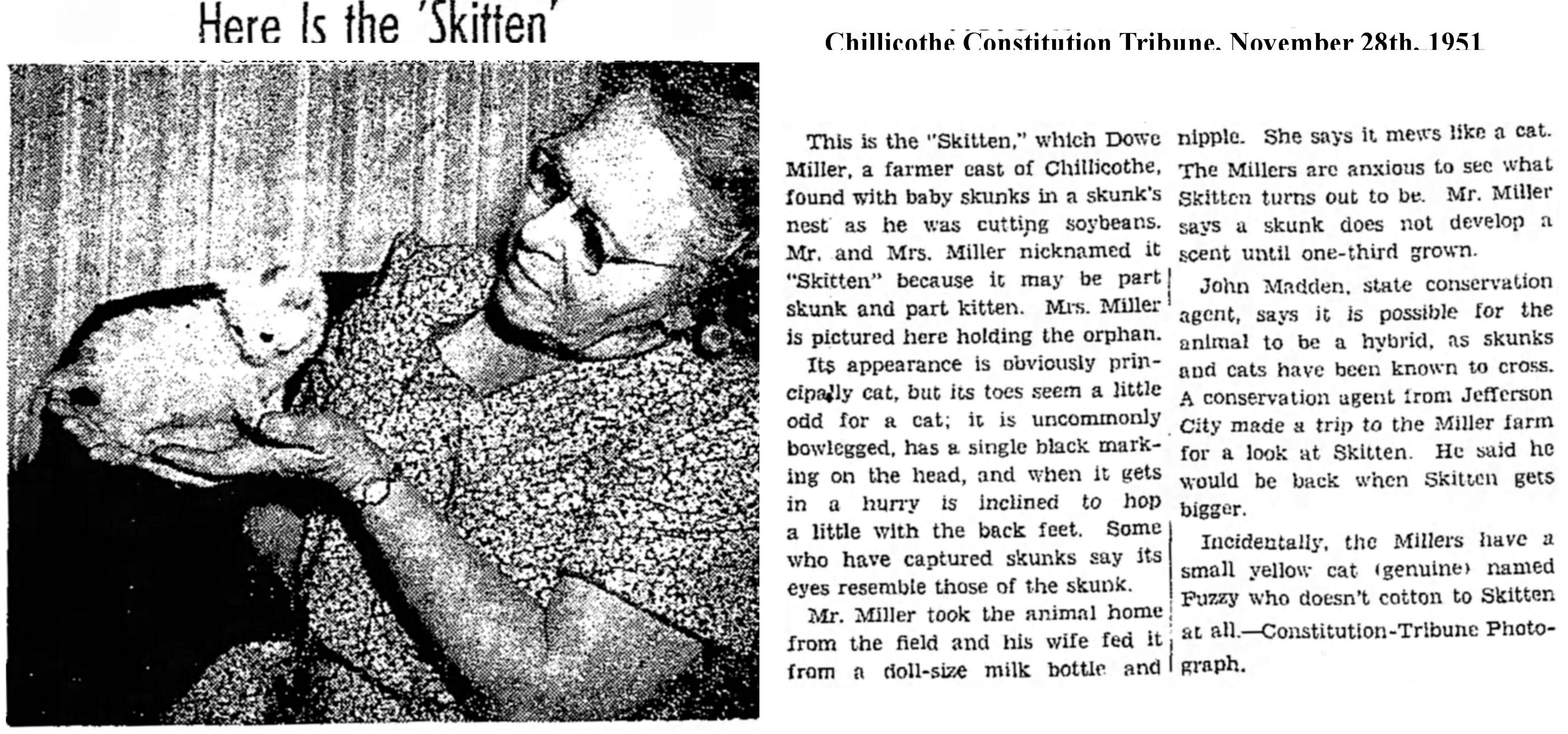
FANCIFUL FELINE HYBRIDS
Throughout history, humans have invented fanciful creatures made up from of two or more real-life creatures. Entirely fictional creatures have been invented for fun or created through misunderstanding. Some mythical hybrids came from attempts to describe new discoveries. The giraffe was called the "cameleopard" and early illustrators (working from verbal or written accounts) drew it as a cross between a camel and a leopard. How else to describe a newly discovered creature except in terms of two already familiar creatures?
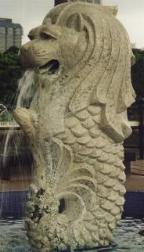
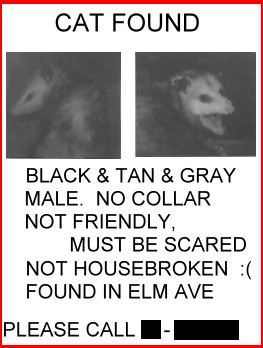
The ancient Greeks and Romans depicted griffons (lion/eagle hybrid), hippogriffs (griffin/horse hybrids), minotaurs (bull/human hybrids), satyrs (goat/human hybrids) and centaurs (horse/human hybrids) and others. The ancient Egyptians depicted many of their gods as human/animal hybrids, usually with an animal's head on a human body. The Sphynx (human-headed lion) is common to many ancient mythologies. All around the world there are tales of were-creatures (lycanthropes) for example werewolves, which are usually shown as hairy humans with various wolflike features. Similarly there are other were creatures e.g. were-tigers in modern fantasy books.
Atti della Accademia Gioenia di Scienze Naturali in Catania, Volumes 8-9 (this was an annual publication and the item in question was originally published in 1835) mentioned a number of hybrids. The horse or zebra and the donkey, the bison and the cow, the wolf and the dog, the ram and the goat, were all possible because they were closely related and similar in size and type. Of the phenomena of hybridity in more distantly related species, the writer was dubious of cases reported by Rafinesque in his Annals of General Physical Sciences. Rafinesque had reported a hybrid fertile mating of a cat and an opossum (didelfo). The writer could hardly believe the report of a fruitful coupling of a dog with a human female, especially given their distant relationship and different body organization.
The photographs show a Merlion (Mer-Lion), a Singaporean emblem with the head of a lion and the body and tail of a fish and an American possum.
Cartoons, particularly Japanese cartoons (anime), feature mutant animals, hybrids, shape-changing animals and anthropomorphic (humanised) creatures. A web-search finds all manner of human/animal hybrids such as "anthro-panthers" and "anthro-wolves". Michael G Coney created races of "specialists" - humans scientifically enhanced with animal genes - in his books "Cat Karina" and "Gods of the Greataway" e.g. a part-hippo opera singer and part-racoon nurses . The creators of one popular role-play game invented winged felines which were magical owl/cat winged hybrids and I used to play a role-play game which had lion-centaurs (leonars).
In real life, hybrids can only occur between closely related creatures and only if they can be persuaded to mate with each other e.g. zebra/horse, lion/tiger, whale/dolphin, wolf/dog. Modern science does away with the need to mate two animals together and can give us laboratory engineered hybrids such as the "geep" (goat/sheep), the cama or camellama (camel/llama) and transgenic creatures where foreign genes have been inserted into the developing egg. It is suggested that "imprinting" occurs in kittens raised by dogs and in puppies raised by cats. Imprinting would cause the young to identify with, and seek a mate from, the foster species. This is a simplistic view and while it works with closely related species (e.g. raising a lion and tiger together, raising a zebra stallion among donkeys), it doesn't appear to hold for fostered cats or dogs as long as they have free access to their own species in adulthood. Dogs and cats take their sexual cues from scent, rather than sight alone. Admittedly this does not stop some uncastrated dogs or cats from trying to mate with any appropriately-sized animal, or with soft toys or the owner’s leg/arm/head. That’s a function of hypersexuality and not due to imprinting. In nature, the ability to create fertile hybrids between closely related species can help conserve genes (over the millennia, some species have diverged to fill new niches, and merged later when a niche is lost).
Whether they result from real science, pure invention, quasi-science, magic or misunderstanding, hybrids fascinate people. Like conspiracy theories, people want to believe in them and resort to the argument that absence of evidence is not evidence of absence. These fanciful hybrids, when not obvious fakes, are a triumph of faith over genetic fact.
CAT HYBRIDS
This piece is devoted to the fictional and fanciful cat hybrids. There is plenty of information on genuine big-cat hybrids such as ligers or domestic/wildcat hybrids such as Chausies or Bengals. It is purely concerned with supposed hybrids between domestic cats and other animals.
Cats are come in a variety of sizes, fur lengths, colours and shapes (tailless, bob-tailed, folded ears, short legs etc). There are also various birth defects which can make one animal superficially resemble another. The visual appearance of a cat which resembleso another animal does not mean it is a hybrid. To be authenticated, a "hybrid" must undergo DNA analysis and (if the offspring dies or is stillborn) post mortem, or it must have been bred under strict laboratory conditions where its parentaage was controlled and recorded. If it proves to be a genuine hybrid, this would be announced in medical and veterinary papers worldwide and the scientist, breeder or discoverer would be able to sell the story worldwide to TV stations, magazines etc.
What about cabbits, squittens and racoon-cats? These hybrids are genetically (if not physically) impossible, but people still want to believe in them. Stories about these hybrids appear in talk-shows, cartoons and alongside "Elvis seen in Fast Food Restaurant" headlines in tabloid newspapers. This piece is devoted to these weird and impossible hybrids.
CABBITS, CATABBITS, RABBICATS, RACATS AND HARE CATS
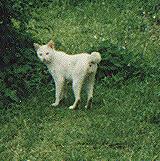
The mythical cat/rabbit hybrid is dealt with in full
Cabbits - What Are They. Rabbits (or hares) and cats are not genetically compatible. There are no scientifically authenticated cases of cabbits. There have been many claims from cat or rabbit owners, but without except these are unproven. Authentication requires DNA analysis or laboratory bred hybrids, not merely visual appearance or circumstantial evidence such as a cat and rabbit being housed together. The term cabbit is the most common one due to Japanese cartoons. A "catabbit" was reported in a 1950s hoax and "racat" is sometimes used in urban legends. The creature described is most often a Manx cat (tailless or bobtailed) or more rarely a Twisty Cat (radial hypoplasia). Both types of cat may have a hopping gait reminiscent of a rabbit. Japanese Bobtails also have pom-pom-like tails. Other names include. bunny-cat, cat-bunny, cat-rabbit or rabbicat. "Bunny Cat" was a name once given to the Abyssinian breed of cat because its brown ticked fur resembles that of a wild rabbit.The belief in cabbits is still strong and modern genetic science has fuelled it rather than dispelled it. If cats and rabbits cannot crossbreed naturally, frustrated cabbit-lovers hope that science can genetically manipulate the two species in the laboratory to produce the impossible creature the want to believe in. This photo does not show a white cabbit, but a Malaysian Bobtail cat from Kuantan.
GUINEA CATS
There are claims from well-educated people in Western Kentucky that cats have been breeding with guinea pigs. The alleged offspring are called Guinea Cats and are now being bred as pets by some people as well as living in colonies of strays. This tale mirrors that of cabbits with people wanting to believe in their existence and own them as pets. As cats are felids and guinea pigs are rodents, they can't cross breed. Even if a small cat and a large guinea pig managed to mate, their genetics and gestation periods are simply incompatible. Even if an egg was fertilised (itself highly unlikely), it would not get as far as cell differentiation due to conflicting instructions from the different parental genes. The same considerations apply to this fictional hybrid (or mistaken identity) as apply to cabbits.
It's more likely that cats have occurred with a mutation or a backyard breeder is mixing-and-matching a number of mutations. It would be possible to mix Munchkin, Rex, Fold and Manx to produce a short legged, longhaired, wavy-furred, fold-eared, tailless cat. Since Manx and Fold are associated with other physical defects that could be made worse in a short-legged cat, any Guinea Cats bred this way would suffer health problems. It's also possible a very long-furred and short-legged line of cats are being bred e.g. mixing persian and Munchkin traits. Rough furred mutations, or simply an unkempt appearance, would add to a guineapig-like look. Such mutations can pop up in random-bred cats without warning and people without any knowledge of genetics might attribute the cats to some sort of cross-breeding.
SQUITTENS AND KANGAROO CATS
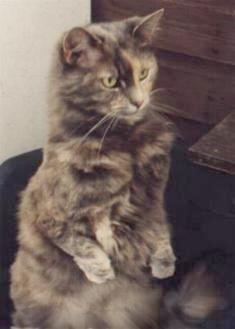
The mythical squirrel/cat hybrid is dealt with in full in
Kangaroo Cats And Squittens Revealed. Kangaroo cats are cats with under-developed forelegs such as occurs with radial hypoplasia or associated conditions. Squittens are mostly due to misidentification of a fluffy, bushy-tailed cat (such as a Turkish Angora) sitting up on its haunches. Many cats occasionally sit upright in order to get a better view. In the late 1800s, some Maine Coon cats were likened to squirrels because of their plumy tails - they were then "identified" as cat/racoon hybrids. This is described in more detail later on.A charming myth about the Norwegian Forest Cat in its home country is that it originated from a squirrel/lynx hybrid hence its plumy squirrel-like tail and tree-climbing abilities. Genetically impossible (even if the lynx didn't eat the squirrel), this inter-species myth is comparable to those about the Maine Coon. A squirrel is an arboreal rat with a fluffy tail (unflattering, but true). It is smaller than a cat and would be regarded as prey. Cats and rodents are not genetically compatible.
MARTEN CATS
In attempting to explain the phenomenon of winged cats, Henry David Thoreau wrote that, according to naturalists, prolific hybrids were produced by the union of the marten and the domestic cat. Martens are mustelids (predatory carnivores related to stoats and weasels) and genetically incompatible with cats.
The squirrel-hunting Pine Marten is also known as the Tree Cat, something which can cause confusion when reading historical accounts of hunting wild "cats" or of garments trimmed with "cat". Another mustelid is still known as a "cat" - the polecat. The Marten Cat hybrid is a misunderstanding rather than a myth. The "wings" of
Winged Cats are caused by fur forming into large mats or by a disorder called Feline Cutaneous Asthenia.CIVET AND GENET HYBRIDS
According to H C Brooke in Cat Gossip during 1926, a recently held cat show in Vienna included a litter of kittens said to have been sired by a Civet-cat on a domestic female. Herr Joe Lesti attempted to find out more details of the remarkable kittens as well as details of a reported Marten-cross. Brooke was dubious that such hybrids were possible. At the same Vienna show there were Tibet Cats, Civets or Genets (Dr Alder had exhibited a Genet at the 1923 Croydon cat show). Brooke himself had exhibited a Civet and an Egyptian cat at Croydon and attracted a great deal of interest. The term "Civet" has been applied to African Wildcats, but it was the viverrine civet that was indicated in the reports.
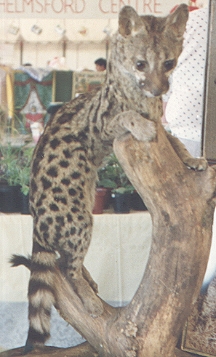
Lilian J Veley, in 1926/7, claimed to have seen, in a Zoo (probably a continental zoo though she could not remember which!) a litter of Civet/cat hybrids. The mother was a large mackerel tabby and the presumed father was a Civet with whom the mother was "certainly on good terms". The alleged results most resembled the cat, but with longer faces, more bushy tails and more blotchy markings. Veley could not say whether they had survived or whether the facts were as told to her by their keeper. She wrote that one should not be too certain that Civets and cats could not interbreed, citing Sir Harry Johnstone who believed it to be one of the ancestors of the Siamese cat (at the time, Professor Moseley considered the Siamese to be a separate species and not true cats). Veley claimed that the claws of the middle toes of the Siamese cat's hind feet did not fully retract and that this was a viverrine trait. The Siamese tail-kink was claimed to be the vestige of a prehensile tail inhereted from a viverrine ancestor, though other authorities pointed out that neither the Civet nor the Genet had prehensile tails. Even the Siamese cat's colour supposedly came from a civet ancestor. This was evidently a person who did not hold with the theory of convergent evolution. Cat-fancier, breeder and writer HC Brooke was dubious. He doubted that the two could interbreed, being from different families. He added that even if they could interbreed, they were unlikely to "fix" a new type since the offspring would breed with either their civet ancestors (losing the feline type) or with cats (losing the viverrine type).
No-one was able to trace the Zoological gardens where the alleged hybrids occurred. Dr P Chalmers Mitchell, Secretary of the Zoological Society wrote, in 1927, that hybrids of cat and Civet, and of cat and Genet were unknown at the Zoological Gardens (London Zoo, Regents Park). He also disabused fanciers of the myth that the Siamese cat was a hybrid between domestic cat and the wild Bay Cat. Capt J G Dollman, Assistant Curator of the Natural History Museum, South Kensington (London) added that the Siamese cat and the Bay Cat were unlikely to interbreed and produce fertile offspring and that the Siamese was most unlikely to have been the product of a cross between a viverrine and a Bay Cat. He identified the supposed viverrine as the Indian (or Yellow-throated) Marten. Siamese cat fancier Lilian J Veley (1926), however, remained adamant that the Siamese was more than just a form of domestic cat, stating that its traits bore some resemblance to a type of viverrine that lived in the region and adding (possibly sensing she was on shaky ground) that the viverrine might be unknown to science. It must be added that this all came about during a spat over whether the Siamese or the Abyssinian was the Sacred Cat of Egypt and that Veley had a vested interest in making the Siamese unique among cats. The Siamese was described as having a "marten-like" face, adding to the belief in hybrid ancestry.
CACOONS AND CATACOONS
The Maine Coon is a large longhaired cat which evolved naturally in the USA from cats imported by early settlers. Harsh winter conditions favoured a type of cat with long fur. Tabby, the original colour pattern of domestic cats, was most common as it offers the best camouflage for a feline predator. Many Maine Coons had extra toes, probably because sailors considered six-toed cats "lucky" and a disproportionately large number of polydactyl cats arrived with English settlers. The confusion between cat and raccoon may have begun with early colonists in North America. Although cats did not arrive in America until they accompanied colonists, Count de Buffon's Natural History (1767) suggested that wild cats existed in pre-colonial America and that a hunter presented a wild cat to Christopher Columbus. These were described as greyish or brown/grey creatures, the size of a normal house cat, with long banded tails. The description strongly indicates a raccoon.
Tabby cats have striped or swirled dark markings on a lighter background and a ringed tail. The tail resembles that of the indigenous raccoon. With no understanding of natural selection favouring a well-camouflaged longhaired cat, the explanation offered for this appearance was that the cats were natural hybrids between cats and raccoons. This is genetically impossible. However, impressionable (or merely stupid) individuals have attempted to mate cats with raccoons. One woman who tried this reported ended up with "an almighty scrap and a pile of fur" when the two animals fought.
Historical Canadian reports have claimed "Le Maine Coon serait le fruit des amours d'un chat sauvage et d'un raton laveur". This translates as "The Maine Coon is said to be the fruit of a love affair between a wild cat and a raccoon." This is partly a play on words because in Canadian French the raccoon is known as "chat sauvage" (wild cat) and many would have been familiar with the robust, thick-tailed European or Scottish Wildcat (les chats sauvages) which the raccoon slightly resembles. However, there were no true chats sauvages in the region, so it would have referred to feral cats (cats which had gone wild).
In 1871, the journal "American Naturalist" carried a letter by TW Higginson regarding coon cats. "I saw yesterday (May 2nd, 1871) the most interesting hybrid animal I ever examined; and hasty as the examination was; it may be worth mentioning. Passing through Taunton, Massachussetts, I saw inthe doorway of Mr Dunbar's bookstore, what struck me, at first, as being the handsomest cat I had ever beheld. The second glance revealed the unmistakable look of wildness; and for a moment it seemed to me that it must be some creature of the squirrel kind, at any rate, something else than a cat. On enquiry, I found it to be the offspring of a domestic cat and a tame raccoon, kept in the same family in China, Maine. I was informed that there had been several litters of these hybrids, and Mr Dunbar had before owned one of a previous litter. [...] It would be exceedingly interesting to compare the different offspring of this strange union. I was unable to ascertain which of the parents - cat or raccoon - was the female; nor could I obtain the name of the person in China, Maine, beneath whose roof these singular offspring were produced."
In his letter, Higginson described a typical Maine Coon cat, but had evidently been completely taken in by the tall tale told by its owner! It is interesting to note the suggestion of an animal of the squirrel kind as this could explain some supposed squittens. He was not the only to be fooled for in 1893, the journal "Science" carried a similar letter from J N Baskett: "I saw in a private house in Chicago recently, two cats which the owners called Coon Cats. They had been obtained in the edge of the forest around Moosehead Lake, and it was claimed that they were hybrids, or descendants of the domestic cat and the raccoon. They werre larger than the ordinary housecat, had very coon-like countenances and bushy coon-like tails that were always expanded. One had the habit of ascending something high, and resting stretched out, and their motions when in a little hurry were a coon-like gallop. The claws were retractile, the foot digitigrade. I did not examine the dentition, but could find nothing but appearance that indicated a coon kinship. They interbreed with the common cat. Can someone tell me more about them?" A related item appeared in he Lowell Sun, November 25, 1893: "Coon Cats. A correspondent of Science tells of seeing in a private house in Chicago recently two cats which the owners called “coon cats.” They had been obtained in the edge of the forest around Moosehead lake, and it was claimed that they were hybrids or descendants of hybrids of the domestic cat and the raccoon. They were larger than the ordinary house cat, had very coonlike countenances and bushy coonlike tails that were always extended. One had the habit of ascending something high and resting stretched out, and their motions when in a little hurry were a coonlike gallop."
Quite a few people did offer information about coon cats. L O Howard had seen a coon cat in the Catskill Mountains in summer 1893 though the cat's owner doubted the popular myth of raccoon hybrids. Morris Gibbs also doubted the hybrid theory and noted that the cats, sometimes called "mule cats" were common in New England. However in 1984, almost a century later, newspapers carried the plea for help from an American woman who had tried in vain to get the two creatures to mate!
CAT/SKUNK HYBRIDS

This hybrid is not a tale of straightforward hybridisation, but one of alleged genetic manipulation. The "original" Ragdoll cat is a large, sweet-natured cat with a variety of myths surrounding its origins. The commonest is that Ragdolls are the result of a female cat which had been hit by a car and whose subsequent litters of kittens were very placid. This is the Lamarckian idea of inheritance - a trait acquired by the parent could be inherited by the offspring. If Lamarck's theory had been correct, many dogs would be born tail-less due to generations of tail-docking. With the car accident tale dismissed by most people, the breeder claimed that the founding mother of her Ragdoll breed had been infused with skunk genes (and even with human genes!) while being treated for her injuries. It was, apparently, some secret experiment. The wonderful thing about conspiracy theories is that people want to believe them and it is incredibly hard to dent their belief because "it's all part of a big cover up". Even if the female cat had been infused with skunk genes, those genes could not have been passed on to her offspring because they would not have entered the germ cells (the unripened egg cells in the ovaries). The cat's immune system would have reacted to the injection of foreign material; just as it would to a vaccination or a transfusion of mismatched blood. Some of the colourways of Ragdoll-derivative cats have been seen as evidence of skunk genes rather. They are due to the well-documented "white spotting" gene which has been seen in cats for decades. While most breeders distance themselves from pseudo-science, a few adhere to the skunk-gene theory.
The Chillicothe Constitution Tribune, November 28th, 1951 published this account of an alleged cat-skunk hybrid: "This is the “Skitten,” which Dowe Miller, a farmer east of Chillicothe, found with baby skunks in a skunk's nest as he was cutting soybeans. Mr. and Mrs. Miller nicknamed it “Skitten” because it may be part skunk and part kitten. Mrs. Miller is pictured here holding the orphan. Its appearance Is obviously principally cat, but its toes seem a little odd for a cat; it is uncommonly bowlegged, has a single black marking on the head, and when it gets in a hurry is inclined to hop a little with the back feet. Some who have captured skunks say its eyes resemble those of the skunk.
Mr. Miller took the animal home from the field and his wife fed it from a doll-size milk bottle and nipple. She says it mews like a cat. The Millers are anxious to see what Skitten turns out to be. Mr. Miller says a skunk does not develop a scent until one-third grown.
J John Madden, state conservation agent, says it is possible for the animal to be a hybrid, as skunks and cats have been known to cross. A conservation agent from Jefferson City made a trip to the Miller farm for a look at Skitten. He said he would be back when Skitten gets bigger. Incidentally, the Millers have a small yellow cat (genuine) named Fuzzy who doesn't cotton to Skitten at all. — Constitution-Tribune Photograph.
In April 2003 I received an email from a person in Cyril, Oklahoma, USA asking whether cats and skunks were related. As well as having seen deformed kittens which the breeder claimed were cabbits, the writer had seen "polecats" (local term for a multi-coloured skunk) and striped skunks mating with cats He had also seen cats nursing kittens that resembled skunks, vocalised like cats but had the odour of a skunk. Another report of the mythical Skunk Cat came to me in April 2008, so the belief seems more widespread than I realised. In April 2008 I received an email about a man who found a Skunk Cat underneath a car in Toms River, New Jersey. According to the witness the cat was black, twice the size of a domestic cat, and had tousled or wild-looking fur. The witness claimed the Skunk Cat was a species documented on the internet (it is documented here, but as non-existent). This appeared to be based on the cat's owner who had put up notices stating she had lost a Skunk Cat. Without having seen the notices or heard directly from the cat's owner, it is possible the cat was a large domestic cat and perhaps the name was "Skunk" in the same way I have referred to my pets as Affy-Cat, Scrapper-Cat etc. One theory was that female cats which had lost their own kittens had adopted orphaned skunk babies. When viewed from above, the dorsal (backbone) stripes of tabby kittens can resemble dorsal stripes of multi-coloured skunks. The odour could be due to the mother cat tangling with a skunk, or using an old skunk den in which to rear her kittens. While tomcats are sometimes indiscriminate in what they mate with (they will mate with pet rabbits), the "mating" skunks and cats is more likely to have been a fight.
WOOF-PUSS, DOCAT AND CAT-DOG
Whoever came up with this dog/cat hybrid was probably joking. With the front end of a dog and the back end of a cat, it spends most of its time chasing its own tail. Woof-puss depictions show the back half of a cat grafted onto the front half of a small dog.
It has been known for randy unneutered tomcats to mount small dogs. Animal behaviourist Peter Neville recorded a case where a tomcat repeatedly mounted a dachshund bitch. The dachshund was producing aberrant pheromones which triggered mating behaviour in the cat. At one time, the hyaena was thought to be some sort of dog/lion hybrid since the front end walks like a dog and the back end is low to the ground like a lion. In early menageries, large dogs once kept captive-bred panthers company. However, all reports of Domestic Cat (F catus) x Domestic Dog (Canis familiaris) in the popular press are based on circumstantial evidence. These animals are from separate genera and cannot interbreed. K Ackermann (1898), H Sternberger (1937), Picture Post (1951).
Alessio Lemoigne (1821-1900) was born in Italy and rejected a military career in favour of veterinary studies. He had a particular interest in biological inheritance which he considered to be a complex issue greatly influenced by the nervous system as well as by the act of fertilization. In 1878, he sent a series of letters to the Royal Lombard Institute of Science and Letters, Milan, Italy, where they were gathered into a volume called "Hypotheses on the Cause of Inheritance in Higher Animals." In March 1879, he reported an experimental study on fertilization "Accoppiamento fecondo di un cane con una gatta" (Fruitful Coupling of a dog with a cat, in Rendiconti, Reale Istituto lombardo di scienze e lettere (1879 - 1879, Serie 2, Volume XII, pp. 210-215, nessun fascicolo (Proceedings, Royal Lombard Institute of Science and Letters (1879 - 1879, Series 2, Volume 12, pp. 210-215, no dossier). My translation is from rather formal Italian into everyday English.
Physiology. - Fruitful Coupling of a Dog with a Cat
Note from the S. C. Prof. A. Lemoigne.
The sciences have prejudices as well as popular beliefs. The need to theorize sometimes pushes the best minds to establish a law based on few facts, and even if the facts are weak, the principle stands without admitting exceptions. It starts with an influential founder whose words are accepted by the majority, and each time his opinions are copied by other writers without critical examination those words increasingly acquire the value of a final decision without appeal. The rules of hybrids was based on the characteristic of the species. The facts casting doubt on the universality of these rules are increasing with hybrids seen between tiger and the lion, between dog and wolf or jackal, between jaguar and leopard, domestic cats with different cats, between rabbit with hare, sheep with goats, goats with the mouflon, swine with wild boar, yaks with zebu, zebu and bison with cattle, cattle with auroch, horses with zebras, asses with quaggas and zebras, and with donkey and mares. All of these contradict the laws, and even the mules, whose sterility once seemed indisputable, now offer numerous testimonies against claiming sterility of the hybrids. In spite of these, we were reluctant to expose, in the presence of those who are authorities, the singular fact that a dog has fertilized a cat, resulting in a fertile hybrid. I would not have resolved to learn more had I not thought that, since this issue had the ring of truth, I need not worry about the consequences. Honesty requires courage.
Mr. Antonio Marenghi, a polite and cultured lawyer residing at 4 Via Arco, Milan, had a female cat that was born in April 1873. This cat, Lala, was given to him when she was very young. She was a mongrel tabby, white underneath with broad patches of grey-brown tiger-stripes and a black spot restricted to the lower lip. She has a short, dense, smooth coat and is well-fed, strong, intelligent and gentle. She was kept indoors and showed a great reluctance to leave her owner's fourth floor apartment, which had a single entrance off the stairway, and no other exits. The apartment door was always kept shut. Lala's aversion became absolute after a passing brute kicked her in the jaw when she was very young and was in the hallway. She barely recovered from the injury which festered in that region. After this, she never left the apartment, either by day or night, and was therefore isolated from other cats. She lived in perfect harmony with a little female dog and with the birds that abounded in that house. She always slept with the lady of the house. Unlike other cats, she has showed a distinct fondness for dogs. Even cats have their foibles! When any type of dog entered the apartment, Lala immediately welcomed him with caresses. Sometimes she didn't stop at caresses and took her friendliness to a degree that exceeded good behaviour, and ran to the kitchen to find, or steal, an appetizing treat, which she placed at the feet of the visiting dog which was astonished by such generosity from its traditional enemy.
After her youth, she came into heat, this was repeated at regular intervals. So loud was her voice and her plaintive cries and appeals that she greatly disturbed her owner, who ordered her to be put outdoors in search of adventure [i.e. in search of a mate]. Futile attempt! She never took advantage of the liberty granted. To get some peace, her owner brought home a suitor for her. She was repeatedly presented with suitors of various breeds and different size, aggressive and bold, and with attention allegedly paid to the aesthetics of the cats. This only had disastrous consequences for the poor aspirants. When they sought union they were all, one after another, relentlessly attacked and scratched by Lala who was so ruthless that, imploring an exit, the suitors were happy to see the door ajar and fled screaming, carrying to the roofs scary news and omens of doom. It was, therefore, never possible to get Lala to mate with cats, and at the time of her heats the owner was forced to moderate them with appropriate medicine! As a result, she had had no offspring prior to the strange event I am reporting here, the details of which were provided by three trustworthy and respectable witnesses. During the winter of 1876 the cat was in heat, and it was during this time that Mr. Orseniga Francesco, a silk dealer (8 Via S. Paulo), a friend of her owner, visited along with his little mongrel dog. Barbini was a small, all-white mongrel. An unheard of thing occurred - Lala gave up her fiercely preserved chastity to her traditional enemy. Until that day she was known to have been an intact Amazon (virgin) among cats. On hearing Lala's cries, Mr. Marenghi, his wife Fraquelli Caterina, and Mr. Orseniga rushed to the scene and separated the two animals with some difficulty and fatigue. (The male was taken care of because of serious paraphimosis (retraction of foreskin) following mating.)
It is most certain that the cat did not leave the house, either before or after that mating, but after 24 hours she ceased to be in heat, and after about nine weeks she gave birth to two offspring. One of these was monstrous, and unfortunately [for Lemoigne and science] was thrown away. We haven't been able to learn any more about it, other than that it resembled a dog, with a dog’s snout, long ears, a pelt of curly white hair, and a small dark spot on the head. The only information is vague and the cat's owners can only remember for certainty that it impressed them as a monstrous being. The other was a handsome male kitten, which has since grown into a majestic adult no different in appearance from other cats, other than a slight tendency of the hair to curl and form sharp tufts. He is white with brindled patches like his mother, but his stripes are smaller and less clear. Like his mother, he has a black mark on the lower lip, but not as dark as hers. His name is Zarin. Zarin had all the instincts and manners of cats; except like his mother he never tried to leave the house. Unlike her he was a great thief and an exterminator of rats. We wanted to introduce him: but felt it inappropriate to make a spectacle of him in case his demeanor became improper. His mother nurtured him, and when he reached adulthood, she became his mate. As a result, she conceived twice, and on the last occasion she produced four kittens. It is worth noting that when she was not in heat, she shunned the company of her mate, but was rapturous if presented with a dog. In one pregnancy she gave birth to the infant we see here. It died after 24 hours. Allowing for imperfect embalming, it has all the characteristics of its mother and no other signs hinting at its father except that one ear hangs down and the other is like that of cats, and it has a small dark spot in front.
This story is important due to the number and the reliability of the witnesses, the amount of detailed information, and the possibility of verifying all of the facts since the animals and named persons are all available. We will not dwell on these perplexing stories, or on the impossibility of the coupling between these two genres, both carnivores, but enemies, and very different from each other in many ways, particularity anatomically. Still less do we want to make deductions regarding the alleged sterility of their coupling or the alleged sterility of living hybrids them. We have preserved the memory of a fact which may have great importance. We believe we have fulfilled an obligation towards our science, entrusting its preservation to the Acts of this authoritative institute. M. E. Yerga. after reading Lemoigne’s letter points out that the facts exposed are grave, contradicting the universal opinion that fruitful couplings don’t occur between animals of different species. Here are animals of not only different species, but different genera. He commended the discretion of his fellow, in simply telling the fact and not making inferences. Auche made some observations on the mechanical difficulty of coupling of the dog with the cat, in particular structure of their parts. Lemoigne noted that he could not expose enough reasons to deny the possibility of the mating in this case.
1936: A letter From Henry Sternberceh of Wilmington, N. C. to The Journal of Heredity in 1936 titled 'A "Cat-Dog" From North Carolina - Hairless Gene or "Maternal Impression"?' included this description of a hairless kitten: Hairless Cat Or Cat-Dog: [...] Around the middle of August, 1936, a curious litter of kittens was born to a perfectly ordinary appearing pet cat, belonging to Mrs. Annie Mae Gannon, of Wilmington, N. C. Of the entire litter, only one of the kittens is perfectly normal in appearance - the other three being freaks. One of the cats has no tail at all; another has only a stub of a tail. But the extraordinary member of this feline family is the fourth—well, we can hardly call it a cat - so for want of a better name, we'll call it a "Nonesuch." It is said that before the kittens were born, the mother cat was often engaged in fights by a mixed-breed dog in the neighbourhood, and on several occasions was badly frightened by the dog. This is about the only plausible explanation as to why the "nonesuch" is so unusual in appearance. In fact, this little animal - now about two months old – is about the queerest looking creature one could hope to set eyes upon. Its face is that of a black, white, and yellow spotted dog. Its ears are quite long and sharp pointed. It has the short whiskers of a puppy. The hind legs are amusingly bowed. It has a stub tail. What makes the nonesuch even more unusual appearing is the short smooth dog hair all over its cat-like body. From the very moment of its birth, which was about twelve hours after the rest of the litter, the nonesuch was surprisingly independent in its actions. It was born with its eyes open, and was able to crawl a little - two characteristics quite unknown to new-born kittens. The nonesuch acts both like a cat and a dog. While it makes a noise like a cat, it sniffs its food like a dog. Nothing delights the nonesuch more than gnawing a bone in a very dog-like manner. When resting, little nonesuch places its paws straight out in front just as a dog would do. The little creature doesn't relish playing with the rest of its family, being entirely contented in stretching out and watching the others frolic about.
Just as one "cabbit report" in a newspaper set off a flurry of similar claims, the story of Nonesuch gave rise to similar claims of dog-cats. The very next year, a Miami woman claimed her cat had produced two kitten-puppies, but it turned out to be a publicity stunt:
March 1937: "Cat declared mother of 2 puppies and three kittens," 16th March 16, 1937, Berkeley Daily Gazette. Laura "Mom" Bedford, of Miami, Florida, announced that her maltese cat (i.e. grey shorthair cat) had given birth to three kittens and two "kuppies" (a portmanteau of kitten-puppies): "I didn't pay them any mind when they were born. I was too busy. I just looked in the box under the kitchen sink and saw what I thought were five black kittens. I figured they would be all right." Two days later, Bedford heard something that "sounded like a dog crying." She examined the litter and discovered that two of them were actually puppies, but they were all being nursed by the cat. The five infants looked very much alike: mostly black with a few white patches. The kittens were female and had 7 toes and the puppies were male. Reporters called veterinarians to ask for their opinions and were tol it was impossible and "never happened." According to the report, a local veterinarian conceded that the birth of kuppies was "very irregular," but admitted that all five animals looked enough alike to be of one family and appeared to be of the same age: "If it is a hoax, somebody certainly went to a lot of trouble to match them up." A few days later, three local residents (Paul Dickerson, Lester Womsley, and Valeria Nobles) had come forward to contradict Bedford's story ("Cat can't have kuppies, it seems, so another good story blows up," 17th March, 1937, Nevada State Journal). Dickerson, a plumber, said, "I was right there when the old cat was having 'em. She had five kittens, the three black ones you saw and two gray ones. Someone gave Mom the puppies for the cat to mother two or three days after the kittens were born. She got rid of the gray kittens a few days later." Veterinarians accepted Dickerson's version of the tale and decided there was no need to do a blood test to determine if the animals were siblings.
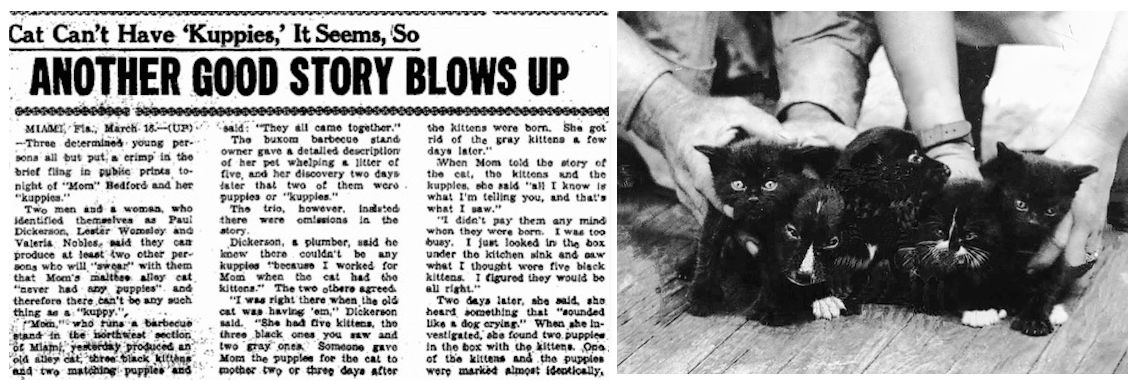
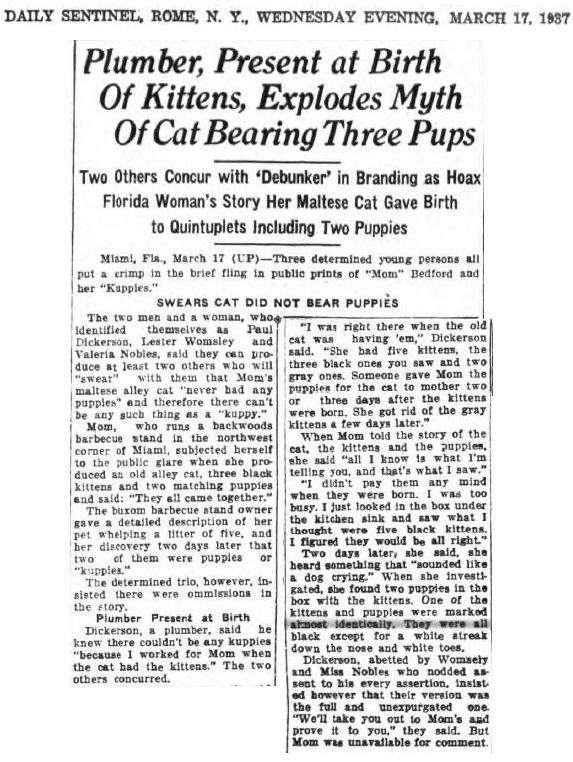
In December 1970, Roy Tutt of Manston, England, claimed to have bred two dog-cat hybrids from his black cat, Patch, and his Scottish Terrier called Bones. He placed an advert in his local paper advertising "Half cat-half dog. Offers invited" and reporters and photographers responded. The story spread around the USA via the Reuters, United Press International (UPI) and The Associated Press (AP) agencies. According to the initial story, Tutt "didn't think much about it at first, but now I feel slightly overwhelmed by the whole thing." Tutt made some TV appearances and was interviewed by reporters attracted to the improbable account and the cute photos. Depending on which publication you read, the offspring were referred to as dats, kuppies, pittens and a variety of other fanciful names. 50 year old Tutt, a pet shop owner and former bookmaker, said he had been trying to mate the animals for ten years and that he fed the hybrids a mixture of cat and dog food. "They are docile and good-tempered and should make good pets. They will eat meat or fish and they make a noise between a yap and a meow." As for those offspring, the accompanying photos showed a pair of fluffy black puppies. Ever ripe for wordplay, headlines asked "Is Dat a Kuppy or a Pitten?" (Independent Press-Telegram from Long Beach, California, page 8). The Sunday News and Tribune from Jefferson City, Missouri, Page 17, December 13, 1970 was one of many North American papers to have run the story: They're called Dats. London pet shop owner Roy Tutt says the balls of fluff displayed here by 16-year-old Sue Kent are something zoologists said could never happen - dats, half dog and half cat. Tutt claims he bred them from a black cat and a Scottish terrier They look like dogs at the front and cats at the hack: These two have heads like dogs but cat fur, whiskers and claws. The Independent Press-Telegram from Long Beach, California, Page 8. December 12, 1970: WILL THEY FETCH THE PAPER AND CHASE MICE TOO? Dats - Dog in Front, Cat in Back - Play in London Pet Shop - AP Wirephoto. IS DAT A KUPPY OR PITTEN? MANSTON, England (UPI) - Call it a puppy cat. Or a pussy pooch. Or even a cog or a dat. Whatever it is, Roy Tutt says it's the result of a romance between a male Scots terrier and a female black cat. "Well, it's not exactly an accident." the 50-year-old pet shop owner said Friday, inspecting one of two small furry creatures with dog's heads but cat's whiskers, fur and legs. "I'd been trying for 10 years to cross a cat and a dog. But I didn't expect anything like this," he said. Tutt said he fed the two hybrids on a mixture of cat and dog food, mostly meat. "This is the result," he said. "I'm still astonished." So, apparently, was a spokesman for Regent's Park Zoo in London, who avowed he "should not have thought it at al possible to cross a dog and a cat." An official of the Canine Defense League said he had "heard of people trying this before, but never successfully." The Royal Society for the Prevention of Cruelty to Animals (RSPCA) refused to comment.
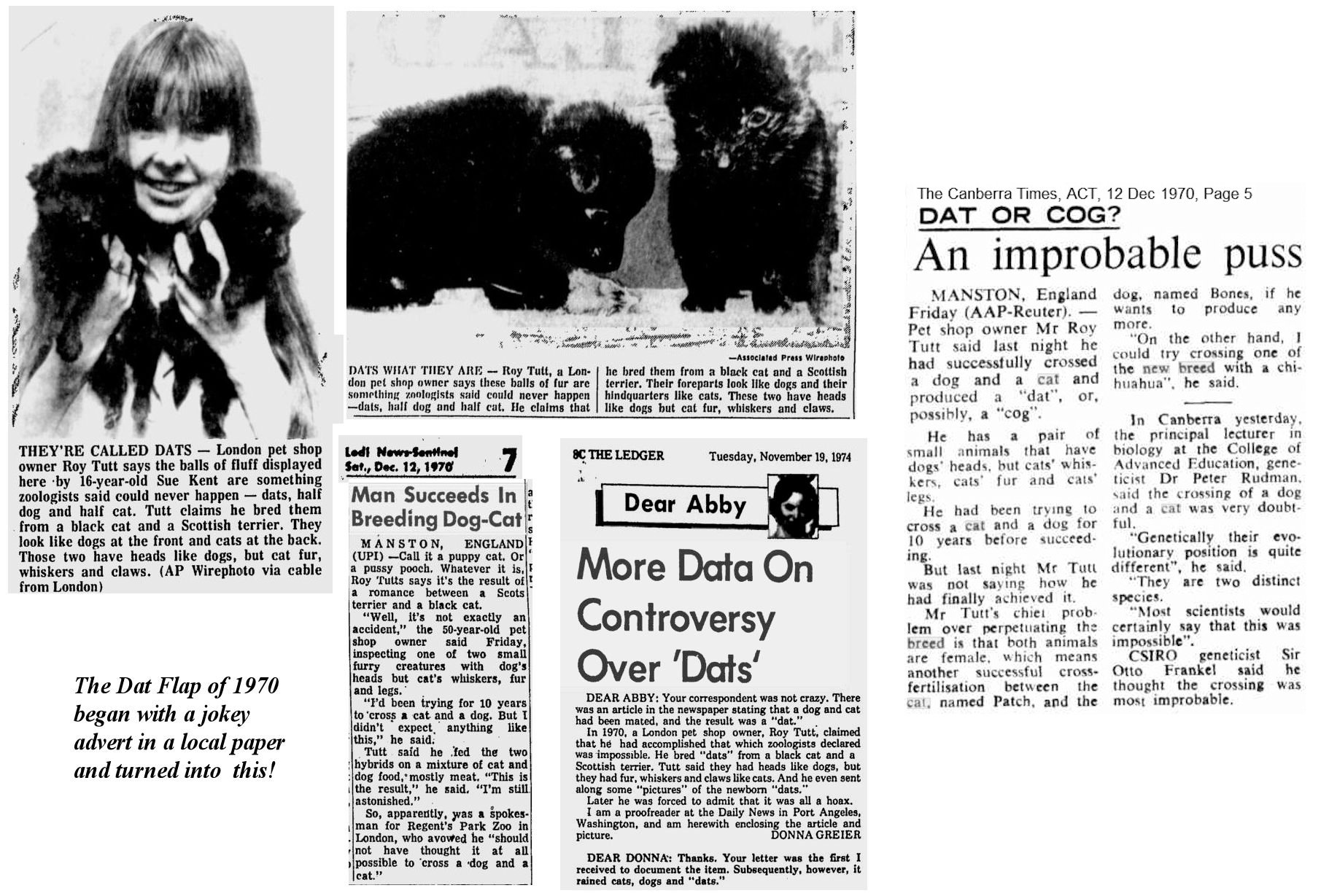
After a few days, Tutt admitted to the hoax and to being a practical joker. The follow-up Reuters story ran as (among various titles) "Dat cat plus dog story just a whole lot of bull." The two furry animals that Tutt, a self-confessed born practical joker, had offered as evidence of successful mating of a dog and a cat were revealed to be nothing more than mongrel puppies that had cost him five shillings each. "The whole thing was a hoax and I hope I have given people a bit of a laugh," he said. Tutt said he had collected a few pounds "for personal appearance interviews and photographs" according to his hand-written confession published in in The People (a UK Sunday national newspaper). He had purchased the puppies for his pet shop for five shillings and placed the local advert as a joke. He said he hadn't expected the story to spread out of the local area, but had felt obliged to keep up the pretence once news agencies became involved.
The story of Roy Tutt was revived (sort of) in the News-Journal from Mansfield, Ohio (page 33) of April 2, 1971 when Jack Smith wrote: Some months ago there was a story in the paper about a pet store owner in Manston, Eng., who had succeeded in cross-breeding a dog and a cat. Since then I've been looking for another story saying the first one was a hoax. But either I missed it or no second story has come along. The man who claims to have produced this cross was named Roy Tutt, a name that doesn't sound any more probable than the story. Tutt said he crossed a black cat called Patch with a Scottish Terrier called Bones and produced two kitten-puppies. An animal half dog and half cat is a fascinating specter. The cross-breeding of different species has beguiled all sorts of mischievous men for thousands of years. Mythologists and writers of science fiction and horror tales have not only cross-bred real animals, but crossed real animals with imaginary animals, bringing forth such hybrids as the chimera, which in Greek mythology was a monster with a goat's body, a lion's head and a dragon's tail. Only the other evening my daughter-in-law was watching a movie on TV in which Charles Laughton crossed human beings with wild animals, such as apes and wolves. [...] Serious zoologists, as well as mere meddlers, have had enough success in the field to encourage amateurs like Roy Tutt, and to make it hard for anyone to be dead sure there is no such thing as a werewolf. The crossbreeding of lions and tigers has occurred often enough that the words tigon and liger are now in the dictionary, tigon being the offspring of a male tiger and a female lion, and liger the opposite. But it's a long way from crossing two species of cats to crossing dogs and cats, and I'll believe it when I see my first cog or dat. Tutt said his kitten-puppies had dog's heads, but cat's whiskers and fur. The Reuters story said they were called kuppies or dittens. but I don't know whether to blame Tutt for that or Reuters. I'm worried by all this casual cross-breeding, not so much because I dislike monsters as because I like the English language. I could much easier accept a dog-cat into the animal kingdom than a word like cog or dat into the language. Kuppies and Dittens, obviously, are possible. Dittens isn't even logical. If you take the "k" from kitten to make kuppies, then you have to take the "p" from puppies to make pittens. Dittens won't hold water. Dat and cog are based. I suppose, on the tigon-liger solution to the tiger-lion problem, which wasn't very imaginative. [...]
On 1st April 2003, news agencies reported that witchcraft had been blamed after a dog in South Africa gave birth to kittens. Vodi the dog was believed to have given birth to three kittens in South Africa after being found nursing the kittens at Winterveld, near Pretoria. Residents believe she gave birth to the kittens. Elijah Mhlanga, Vodi's owner, said her behaviour changed after she had disappeared earlier. "I was worried when she disappeared. When she came back last Sunday, she was different. She hid from us and stopped barking. She also refused to eat," he told the Daily Sun, "On Monday my grandchildren called me and said Vodi had given birth to kittens. I did not believe them. I thought the puppies just looked like kittens to them." Mr Mhlanga went to investigate and apparently found Vodi nursing three kittens which she tried to hide under her belly when people came to look. Animal welfare officer Meshack Matlou said he had never seen anything like it: "We will do some tests and the results will tell us what happened," he said. It could simply be an April Fool joke; many newspapers and websites were running hoax stories that day. That an animal welfare officer apparently spoke of doing tests (dogs and cats cannot crossbreed) suggests either a hoax or human gullibility! The only way for a dog to give birth to kittens is through embryo transfer as used in zoos and laboratories where surrogate mothers bear the offspring of related, but rare or endangered, species. Dogs with strong maternal instincts might adopt abandoned kittens or drive off the mother and kidnap the kittens. That Vodi was apparently suckling the kittens suggests that she had either recently lost her own puppies or had had a phantom pregnancy. A few bitches start to produce milk in response to being suckled, but this takes a few days and the foster kittens/puppies have to be hand-fed until sufficient milk is produced. The question is: Will the kittens grow up into cogs?
Then in July 2003, The Weekly World News (similar to the UK's Sunday Sport tabloid) warned Americans to beware of "Docats". This terrifying new species of mutant predator was apparently roaming US streets, preying on the homeless in America's cities. "Concerned researchers" claimed the Docat to be a strange canine/feline hybrid which could have killed and eaten more than 100 homeless persons in the previous 12 months. Presumably this dog-cat was a big cat hybrid!
In November 2006, 18 year old Brazilian student Cassia Aparecida de Souza, claimed that her cat, Mimi, bore puppy-like offspring three months after mating with a neighbour's dog. The photo showed offspring with pronounced muzzles. These alleged feline-canine crossbreeds are puppies as it is not possible for a cat (38 chromosomes) and dog (78 chromosomes) to hybridize. The cat had given birth to 3 kittens which did not survive and had evidently adopted some puppies to take their place. Nursing mother cats (and those who have lost their own offspring) have strong maternal instincts and will abduct or foster other species' offspring. There was also speculation that the cat's owner, who is poor and pregnant, deliberately perpetrated the hoax in order to get money. Alternatively, she was simply ignorant about feline maternal instincts.
A dog brought home from Liaoning city became a celebrity in a Chinese village after the owner claimed she gave birth to a kitten. Hua Chengpeng, of Huayang village, Jiangyan city, told People's Daily that the kitten was the third 'puppy' in his dog's litter. He said that the first two puppies the dog produced were normal, but the dog then produced the kitten. Local vets said it was a puppy with a gene mutation that made it resemble a cat. It apparently yaps like a puppy. The photo circulated with the story very clearly showed 2 puppies and a much younger tabby kitten in which case it is not possible for it to be a gene mutation; just a kitten that the bitch has adopted alongside her two puppies and which is learning the mannerism of its canine family. It is likely that the dog's owner is simply enjoying some temporary fame, but it is very worrying that his vet can't distinguish between a puppy and a kitten!
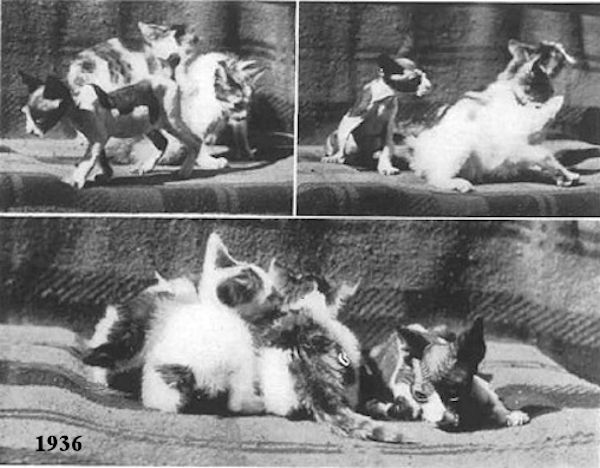 Following suit, the 2011 Catster blog April Fool was "Cornell's Genetic Breakthrough Creates Cat-Dog Hybrid" and featured a photomanipulation of a colourpoint-type cat with a pug dog's eyes and muzzle. In the spoof, a Dr Kwiecien Zywnosci announced that Cornell University’s School of Veterinary Medicine, in conjunction with UC Davis and New Zealand's Massey University had produced the first proven living cat-dog hybrid, a male named "Kotpies" (Polish for cat-dog") after 15 years of genetic research. In the story, a genetic breakthrough in 2006 identifying "a multiplex single-base primer extension reaction in the cytochrome b gene" in both cats and dogs, provided a DNA location where canine DNA could be combined with feline DNA through chromatin transfer and the resulting modified embryos carried to term by a female cat. The resulting adult hybrid both barked and purred! The April Fool's joke cat-dog Kotpies, of course, was a genetically certified cat-dog hybrid confirmed by UC Davis’ Lester A. Lyon, PhD (the real-life geneticist being Leslie A Lyons) - his body being pure cat, but his eyes and muzzle being canine! According to Zywnosci, the team couldn't control how the canine DNA manifested, but hoped to do so in the future to create hybrids with custom characteristics!
Following suit, the 2011 Catster blog April Fool was "Cornell's Genetic Breakthrough Creates Cat-Dog Hybrid" and featured a photomanipulation of a colourpoint-type cat with a pug dog's eyes and muzzle. In the spoof, a Dr Kwiecien Zywnosci announced that Cornell University’s School of Veterinary Medicine, in conjunction with UC Davis and New Zealand's Massey University had produced the first proven living cat-dog hybrid, a male named "Kotpies" (Polish for cat-dog") after 15 years of genetic research. In the story, a genetic breakthrough in 2006 identifying "a multiplex single-base primer extension reaction in the cytochrome b gene" in both cats and dogs, provided a DNA location where canine DNA could be combined with feline DNA through chromatin transfer and the resulting modified embryos carried to term by a female cat. The resulting adult hybrid both barked and purred! The April Fool's joke cat-dog Kotpies, of course, was a genetically certified cat-dog hybrid confirmed by UC Davis’ Lester A. Lyon, PhD (the real-life geneticist being Leslie A Lyons) - his body being pure cat, but his eyes and muzzle being canine! According to Zywnosci, the team couldn't control how the canine DNA manifested, but hoped to do so in the future to create hybrids with custom characteristics!
In this April Fool story, cat-dog hybrids had long been rumored to occur naturally, but had never been proven. It quoted a real journal article, a report on a hairless kitten or "cat-dog" from the American Genetic Association's Journal of Heredity in 1937, when a cat-dog was alleged to have occurred in North Carolina: In Wilmington, N. C. last August, Mrs. Annie Mae Gannon’s cat littered in her boarding house. First came one normal, one tailless and one bobtailed kitten. Twelve hours later Mrs. Gannon’s cat bore what looked like a splotched, botched Boston bull pup. Colored black, yellow and white, it had long, sharply pointed ears, short whiskers, stub tail, short doggish hair. Unlike cat or dog it was born with eyes open. And it could crawl at once. As it grew up it made noises like a cat, sniffed and gnawed bones like a dog. It rested with its paws stretched forward dog fashion, refused to frolic with its litter mates. A neighborhood mongrel dog was blamed for the freak. Dog and mother cat had fought all through her gestation. Mrs. Gannon’s neighbors argued that those fights had marked the kittens. Henry Sternberger, who photographed the catdog and named it Nonesuch, thought that cat and dog might have mated. In any case, decided he, this was a freak in which the American Genetic Association should be interested. Mrs Gannon refused to hand her cat-dog hybrid over to scientists in case it were harmed and Robert C Cook, Editor of the Association’s Journal of Heredity dismissed it as simply a gene mutation. In fact the paper was about "maternal impression", alleging the kitten's strange appearance was due to the pregnant mother having been frightened (not impregnated) by the neighbour's dog! (The full report is at Hairless Cats, and describes a hairless kitten called Nonesuch.)
Modern Dog Magazine April 1, 2014. Early this morning, scientists at Liger University released a statement reporting the discovery of a here-to unknown species that appears to be a dog-cat hybrid. The animal was discovered living in a small colony in caves near Lyon, France, apparently subsisting on bats. A local woman who saw the scientists emerge with one of the new species, for now being referred to as "dat," was reported as exclaiming, "Agh! C'est un monstre!". Reactions are mixed, however; the university has reported being besieged by calls from individuals interested in adopting a dat. UPDATE: near relative of dog/cat hybrid "dat" discovered in neighbouring village. For now it is being called "cog."
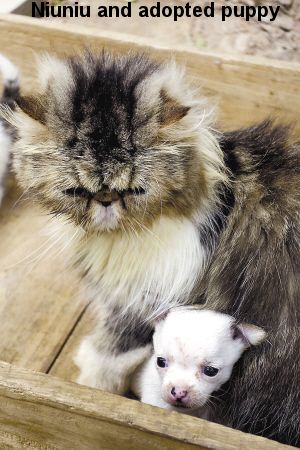
According to the English-language Korea Herald (18 July 2012), which picked up the story from the Yonhap News, a 63 year-old Korean man's dog gave birth to a kitten. Jeong Pyong-bong told reporters that his cat-loving dog who "got up to some mischief with the alley cats", got pregnant in May 2012 after several nights on the tiles. In July, the dog gave birth to a litter of puppies and a single black and white kitten. "It's quite true. This is a miracle. After the little animal was born I stared at it in disbelief. It looked like a cat and was meowing like a cat. So how can it be a puppy? People from all over town have been calling at my house to have a look as the news has spread." Professor Son Chang-ho of the Chonnnam National University College of Veterinary Science said that a dog cannot give birth to a cat as they have different numbers of chromosomes. It was possible that this was a puppy that had some slight deformations and resembled a kitten. However, the accompany photo clearly showed a kitten that the maternal canine had adopted, no doubt from one of the aforementioned alley cats.
May 2015: 74 year-old Jia Weinuan, in China, claimed that his cat had given birth to a Chihuahua. Photos show it is very obviously a puppy (breed not determined) and the kittens are all Exotic Shorthairs i.e. he is a breeder. The maternal cat probably adopted an abandoned puppy that was similar in size to her kittens. Jia claims to have personally cut the umbilical cord of the puppy, so he knows that it is definitely the child of the cat. The mother is an Exotic Shorthair (the shorthaired version of a Persian) called Niuniu, although newspaper reports misidentified her as an American Shorthair. The father is the same breed (judging by the kittens). Niuniu gave birth to a litter of five kittens - or if the story is to be believed, 4 kittens and a Chihuahua (though it looks more like a Jack Russell Terrier). The puppy-kitten does not mew, but squeaks "chi-chi" and Jia acknowledges that its private parts are wrong for a cat, but correct for a dog. Not only does the Chihuahua-kitten look very dog-like, but also it makes a "chi chi" sound instead of a mew. And then there's its private part, which, much to Jia's puzzlement and consternation, is in the right place for a dog, but the wrong place for a cat. Jia also owns five dogs, but insists that Niuniu did not mate with any of them because she is a good cat who would never "do bad things without us knowing." In addition to which, the two species are genetically incompatible. While he has homes for the kittens, he says no-one seems to want a puppy born of a cat because it's bad luck.
BADGER CATS
|
Spot the difference - a raccoon, American badger and skunk. |
While this isn't really a claim of a hybrid, this claim that some black and white cats are really badgers deserves mention as it's on a par with resemblance of some tabby cats to raccoons. I couldn't work out if the writer was terminally confused or attempting some sort of hoax.
In May 2007 I had an email from a Los Angeles resident who had tamed a pregnant black and white feral cat which he insisted was really a badger. He claimed he had a "feline that looks just like a cat" (a nonsensical statement in itself since felines are cats) taken in as a stray and tamed over 2 years. She'd been living in a tree in his garden and only came out at night. One day several "magpie cats" entered the neighbourhood and he claimed that their social organisation was atypical of cats, but typical of badgers. The local Fish & Game Department claimed they were badgers, but that may have been based on his description and not on seeing the animals for themelves.
The vet who aborted and spayed his female magpie cat apparently said it was a mustelid (i.e. a badger or skunk) of some type. The writer claimed the cat had once done a handstand and sprayed a dog just as a skunk would spray. His "feline" makes him aware when badgers pass through the neighbourhood in a pack, the female badgers sometimes being friendly. The passing badgers have nimble paws and can manipulate objects and open outdoor closets (after which they all pile in - which sounds like raccoons!) and are intrigued by mirrors because they "can see objects closer then six feet, unlike cats which can see objects further away". Badgers may be short-sighted, but cats can certainly see objects closer than 6 feet! Just like the writer's feline, the apparent badgers didn't lay in the sun. His friend's 3 unrelated Tuxedo Cats also got along socially and never lay in the sun (and by his logic were therefore badgers, not cats!).
Based on this, the writer claimed some magpie cats and tuxedo cats are actually badgers. He had owned cats previously and knows that "one of my felines is not a cat" - which is nonsensical since if it is not a cat then it is not a feline! He believed the only way to tell a cat from a badger was its behaviour as they were physically indistinguishable. He also believe that tuxedo Cats and gingers discussed on Messybeast.com were sometimes mustelids, not cats - this being incorrect as Messybeast only discusses cats, not badgers or skunks.
Some people who had what he believed were unneutered female badgers had offered large rewards for lost pets that the writer believed had joined passing badger troupes! The confused writer stated "you can only identify a cat from a badger through their behavior" and "There is no way to look at them and tell the difference". His vet would certainly have known the differences - in order to spay the animal the vet needs to know how much and what type of anaesthetic to use and the shape and location of the uterus, these are different in different species. Perhaps the vet was referring to the animals seen in the yard not the animal he was about the spay.
All of the above is nonsense. Badgers and cats are very different animals and look different - saying they cannot be told apart is nonsensical as even people unfamiliar with American mustelids would be able to tell that an animal wasn't a cat when at close quarters. Badgers are wide-bodied and short-legged with longer snouts, rounder ears, strong jaws and claws suited to digging burrows. Badgers are burrowing animals and don't live in trees. Feral cats also live in colonies.
HYBRIDS IN MYTHOLOGY AND LITERATURE
Ancient Egyptian, Greek and Roman mythology created a number of fanciful inter-species feline hybrids, mostly incorporating lions (a potent symbol of power and savagery).
|
Greek Winged Sphynx |
Chimera |
Chimera, this time showing the goat's head as well as the lion and snake heads. |
The most familiar is probably the sphynx (sphinx), usually depicted as a combination of lion's body and human head and chest. It is a statement of lion's power combined with the human's wisdom. Egyptian sphynxes included man-headed, ram-headed and hawk-headed versions. The Greek sphynx had the head an and breasts of a woman, the body of a lion and was winged. Various styles of sphynx are depicted in art and sculpture throughout the classical world.
|
Greek sphinx |
Egyptian Sphinx |
Ram-headed sphinx |
The Egyptian fertility goddess bast (Bastet, Pasht) was generally depicted as a cat-headed female. Early South Americans depicted similar beings, for example puma or jaguar heads and torsos combined with the arms and legs of humans. The merlion of Singapore combines lion and fish.
Greek mythology (much of which was adopted by the Romans) is also littered with fanciful amalgums of the lion with other creatures. The griffin (gryphon) had the head and wings of an eagle and the body of a lion. Although it normally feasted on horses, it sometimes mated with mares (generally white ones) to produce the hippogriff (hippogryph) which had the wings, claws, and head of a griffin and the body and hindquarters of a horse. The manticore had the head of a horned man, the body of a lion and the sting-tipped tail of a scorpion (some manticores had a dragon's tail). The chimera (chimaera) was a fire-breathing she-monster combining a lion's head, a goat's body and a serpent's tail.
|
Griffin - part eagle, part lion (these two are at the British Museum and were made by Wedgwood) |
Hippogriff - part griffin, part horse |
Manticore - scorpion, lion and human |
|
Griffin: this one is on Holborn Viaduct, London |
||
Hybrids of big cats occur in African folktales - the marozi is a spotted lion which may be a colour form of the lion or, less likely but not impossible, a hybrid of leopard and lioness. The dogla of India is reputedly a tiger-leopard hybrid and again, this is within the bounds of possibility although an aberrant colour form of the tiger is a more likely explanation (deliberate matings of tigers with leopards have resulted in spontaneous abortions).
Such fanciful notions have stayed with us into the modern age: Michael Coney's "specialists" and the cat-like humans of fantasy novels, fantasy artwork and films and TV series (e.g. Doctor Who) and range from lithe, spotted cheetah-people through to regal leonesque humans and even big-eyed cat-monkeys. Cats are also symbols of sexuality (think of Catwoman in Batman) and lust, something Aishling Morgan has used in a series of erotic fantasy novels featuring oncathropes, acyonthropes and tiganthropes (humanoid versions of panthers, cheetahs and tigers respectively).
|
A demonic "bat cat" with human-like torso. |
Fantasy winged cat |
Bast in human form with cat's head |
Some modern fantasy novels, such as the dungeons and dragons genre, and role play games have not only adopted fanciful big cat hybrids from classical mythology, they have created innumerable combinations, e.g. black panthers with medusa-like snake-headed lion's manes; winged cats magically bred from owls and cats; lion-centaurs with the bodies of lions but a human torso, arms and head in place of the lion's head.
The leonar (or leonaur) or leo-centaur is a lion centaur (the equine version is sometimes referred to as a hippocentaur in mythology).
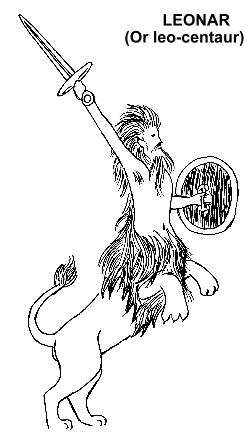
You are visitor number